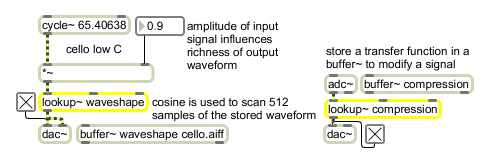Examples

Transfer function lookup table
| Name | Type | Opt | Description |
|---|---|---|---|
| buffer-object-name | symbol | Obligatory. Names the buffer~ object whose sample memory is used by lookup~ for table lookup. | |
| sample-offset | int | opt | After the buffer~ name, you may specify the sample offset in the sample memory of the buffer~ used for a signal value of -1. The default offset is 0. The offset value is followed by an optional table size that defaults to 512. lookup~ always uses the first channel in a multi-channel buffer~. |
| int | offset and table-size [int] |
The settings of offset and table size can be changed with a number in the middle or right inlets. If a signal is connected to one of these inlets, a number in the corresponding inlet is ignored. |
| float | offset and table-size [float] |
The settings of offset and table size can be changed with an number in the middle or right inlets. If a signal is connected to one of these inlets, a number in the corresponding inlet is ignored. |
| (mouse) | Double-clicking on lookup~ opens an editing window where you can vieW the contents of its associated buffer~ object. | |
| set | buffer-object-name [symbol] |
The word , followed by a , changes the associated buffer~ object. |
| signal | In left inlet: Signal values are mapped by amplitude to values stored in a buffer~. Each sample in the incoming signal within the range -1 to 1 is mapped to a corresponding value in the current table size number of samples of the buffer~. Signal values between -1 and 0 are mapped to the first half of the total number of samples after the current sample offset. Signal values between 0 and 1 are mapped to the next half of the samples. Input amplitude exceeding the range from -1 to 1 results in an output of 0. In middle inlet: Sets the offset into the sample memory of a buffer~ used to map samples coming in the left inlet. The sample at the specified offset corresponds to an input value of -1. In right inlet: Sets the number of samples in a buffer~ used for the table. Samples coming in the left inlet between -1 and 1 will be mapped by amplitude to the specified range of samples. The default value is 512. lookup~ changes the table size before it computes each vector but not within a vector. It uses the first sample in a signal vector coming in the right inlet as the table size. |

| Name | Description |
|---|---|
| buffer~ | Store audio samples |
| peek~ | Read and write sample values |
| MSP Tutorial 12: Waveshaping | MSP Tutorial 12: Waveshaping |